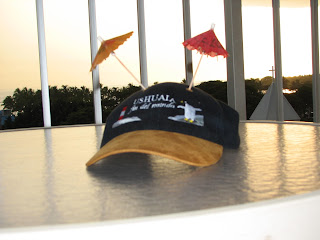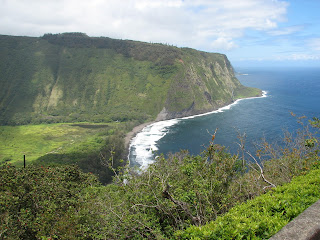BEWARE OF CUTE FURRY THINGS IN PARADISE.
We have spent a lot of time driving the highways and back roads of the big island. Along the way we have spotted this little furry ferret like creatures that darted back and forth across the road. On one outing we counted over a dozen that had become road kill. AWWW
Forget the pity. We have discovered that these cute little
creatures are actually mongoose. They
were brought to the island during the days when sugar was king and released
into the cane fields to eradicate the rats that were brought over as unwanted
cargo on another ship. It seems that the
mongoose (mongeese?) are lazy and rather than chase rats, found eating the eggs
and the young of the Nene, the state bird of
Photo: Outferia
The Nene are now an endangered species because
of this scheduling conflict. We also found out that they are the off spring of
Canada Geese that somehow found there way to the islands hundreds of years ago
and never left. I can relate, as I am
certainly going to find it hard to leave when the time comes. They cannot be
related to the geese found around
Photo:animal.birds.com
Much of the flora and fauna that you will find on the islands today is not indigenous to the island prior to man arriving.
A short fauna list includes:
Rats- They arrived on the first ships to find the islands. There were no natural predators, so they flourished.
Mosquitoes- The mosquitoes arrived in the barrels of stagnant drinking water carried in the holds of the early ships. The barrels were emptied into the fresh water of the island when they were being refilled for the return voyage. The mosquitoes brought with them avian disease which they introduced to the native bird population and continues to kill thousands or native birds to this day.
Cows- Captain George Vancouver brought the first five cows to the island as a gift to King Kamehameha. At Captain Vancouver’s recommendation, King Kamehameha placed a kapu on killing or harming the cattle for 10 years. They flourished and in a few decades the wild herds got so big that they threatened the rain forest’s existence. Samuel Parker was given the task of dealing with the thousands of wild cattle. He domesticated a large number and culled the wild herd. This was the start of the huge Parker Ranch which still exists today on the big island.
Pigs- What is a luau with out pig. Pigs were introduced to the island, most
likely by the first Polynesian travelers.
Wild pigs continue to populate the island. The wild population got so bad that the pigs
were destroying the islands rain forest habitat at an alarming rate. There is a
twelve month hunting season for pigs even today. The pigs eat the moss that coats much of the
forest floor. Their rutting leaves holes
which allow water to collect and become breeding grounds for mosquitoes. The mosquitoes in turn spread avian disease
to the local birds. Many who have no natural resistance and die. Thousands of
birds die each year in the park vicinity so the
Photo: Pinterest- Leah Davis
The list of introduced flora is also long and includes coconut palms, many of the colourful flowers, taro and poi. The flora grew unchecked and in many cases pushed out the local fauna. It is estimated that thousands of different indigenous plant life has become extinct on the big island.
THE
A really, really, really lazy day! We did not leave the lanai till almost 2:00
PM. We did complete the booking of a helicopter flight over the volcano. We have booked with Tropical Helicopters
based out of the
I have also booked a hotel for us in
Our one week wireless internet special died today so I have signed us up for another week. I am quite helpless with out access. I think I may have an addiction problem. Back in service and a quick email to our kids. Out the door and into the gas guzzler for a quick trip to Safeway. We need dinner tonight and something for lunch tomorrow. Back to the condo to dump off our groceries and we head out in search of a few postcards and a Mai Tai.
We wandered around the shops for while and bought 6 postcards. Now off to an appropriately located bar for a Mai Tai and some postcard writing. Two Mai Tai later (Only one for Nonie) and we are headed back to the condo to prepare a dinner of ham steak and some sort of bagged rice side dish. My nips were lumb and I walked home with two little umbrellas stuck in my hat and some strange looks. I guess two Mai Tai are my limit.
Shock! It seems that my extended stay on the lanai today has resulted in half my body receiving way to much sun. I do not remember being out in the sun that long but I guess I was because my left half is really really red, sun burnt red. No pain yet, but look out tomorrow. I knew that the lanai was too good to be true. Like any good thing, too much can be a bad thing. See Mai Tai above. I think that I will have to start weaning myself off the lanai or the withdrawal when I get home will be too painful. I may move out to the patio for little sessions once we get back to soften the withdrawal. Not sure what I can do at work. Perhaps the patio at the Barking Parrot?
We were on the road pretty early today. Due to my recent problems with lanai abuse, I felt it best that I start to wean myself off. We are on our way to the Waipi’o Valley. The valley is located on the east side of the big island about 20 miles from Waimea.
The valley is another site that has significant history to the Hawaiians. It is home to Kamohaoli'i the Shark God as well as the legendary doorway to the land of the dead and has been a burial site for almost 500 years. . Seemed like a great place to go for a hike.
The valley was home to over 4,000 inhabitants when Captain Cook visited. It is now home to practically no one. The valley is very lush and fertile and looks like it can grow anything. The depopulating started during World War II as people were lured away by the modern conveniences of towns. Then in 1946 the valley was hit by a tsunami which rolled half way up the valley. Then a massive rainfall in 1979 dumped over 45” of rain in less then 24 hours. The flood and landslides further devastated the valley and chased the few remaining inhabitants away. There are still a few taro farmers and rumor has it that they also grow some great medicinal plants. A different Kona Gold.
The road / goat trail into the valley starts at a beautiful lookout. The parking lot was full when we arrived but as we drove up, a car pulled out and we were able to park. OHOH! To reach the valley floor requires a four wheel drive or a one mile walk down the steepest road, I have ever seen. The walk down was quick. Along the way we met two girls who were just hiking back up the road. They were just returning from an overnight hike into the next valley, Waimanu which can only be reached by a goat trail up the opposite wall of the valley and a 6 mile hike. They looked very tired but exhilarated.
At the bottom we took a right hand turn towards the beach and walked about a ¼ of mile over what looked like a permanently wet muddy road. The effort was worth it.
At the end was a beautiful waterfall cascading down the valley walls an out into the ocean. To get to the bottom of the falls required a walk along a very rocky shoreline.
There were a few people scattered around but not enough to spoil the atmosphere.
The 15 minute stroll down turned into a 25 minute calf burn to get us back to the top of the road. We had left our lunch in the Jeep so we rewarded ourselves with ham sandwiches.
While we were eating we watched a Hawaiian lady making neat little little flower things from palm fronds. I bought a couple of flowers that she had made from split palm fronds as they would make a great addition to my palm frond hat.
After lunch we headed back to the small
town of
We returned to Waimea and a visit to the
The ranch was started by Samuel Parker in the early 19th Century when King Kamehameha deeded two acres to him and 450 acres to his wife who was a descendant of Hawaiian royalty. He had been asked by King Kamehameha too help them deal with wild cattle that were the legacy of a present from Captain George Vancouver. During its heyday the ranch was over ½ a million acres.
It is currently around 150,000 acres. The last living Parker heir died in 1992
without leaving his own heir. In his
will he bequeathed the ranch to a charitable group. Now all the profits from the ranch go to four
local Waimea groups. We were told that
the hospital is one of the charities and it is the best equipped hospital in
all of
Back on the road with a short stop a Safeway for some supper stuff. We ate a lovely tuna salad out on the lanai but I came right in as soon as dinner was over. I was continuing to wean myself from the lanai.













No comments:
Post a Comment